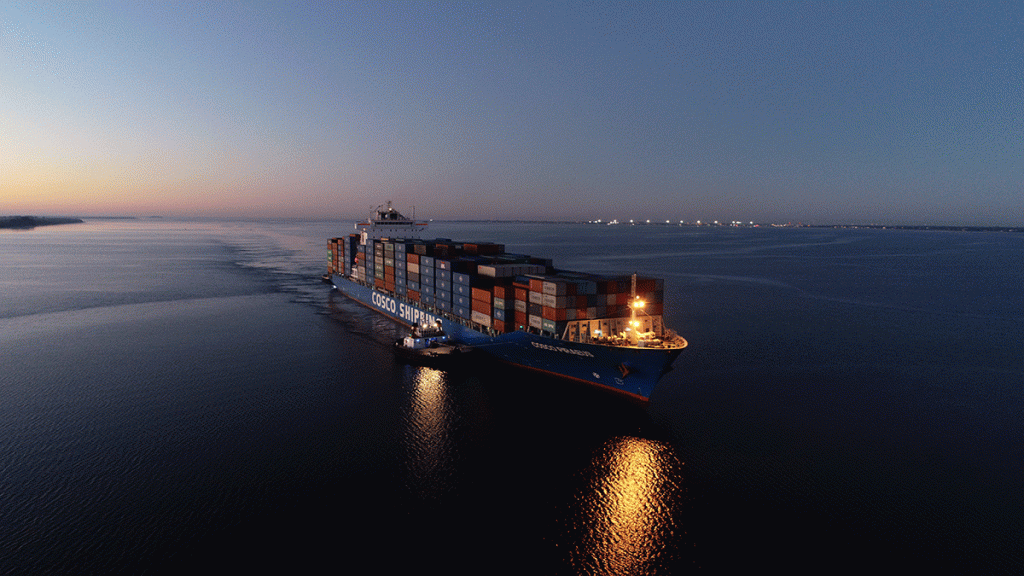News & Updates
Reroute Your Thinking: Port Tampa Bay Offers Supply Chain Alternative Amid Congestion
In 2013, Port Tampa Bay President & CEO Paul Anderson had a bold vision to grow Port Tampa Bay into a major container port. He encouraged shippers and retailers to Reroute Your Thinking™ and look for more efficient ways to serve the growing Florida market. As congestion worsens elsewhere, Port Tampa Bay stands ready to serve as a supply chain solution and alternative.
The Florida Ports Council and Governor Ron DeSantis recently outlined how the state’s seaports stand ready to offer a supply chain alternative and solution to the congestion seen on the West Coast and elsewhere. Each day, more and more ships are anchored off the coast of California, waiting for their turn to come into port and unload the products Americans need.

Port Tampa Bay joins the Florida Ports Council in proposing that the most efficient way to move consumer goods through the state, region, and beyond needs to change. Florida is now the third most populated state in the nation, with more than 21 million residents and welcoming over 100 million additional visitors every year. Florida also now has the 15th largest economy in the world. The importers and exporters who support this huge consumer market deserve a Florida First supply chain strategy with expanded direct ocean container services calling Florida ports directly, as opposed to the indirect routes via congested out of state ports, which is how much of this business unfortunately continues to move.
Throughout the pandemic, and into the holiday season, the demand for goods and imports continues to surge. The Tampa Bay region combined with the I-4 Corridor is home to almost half of Florida’s population. With more than 400 distribution centers, the I-4 Corridor is fueling demand for everything from retail and e-commerce goods, food & beverage, to energy products, and construction & building materials.
Port Tampa Bay is not seeing any of the congestion or delays that have been creating issues for other ports. Our port stands ready to welcome new business and serve as a supply chain alternative and solution. Port Tampa Bay’s container volume has increased by nearly 30 percent over the past year, and our port has easily accommodated this growth by staying ahead of the curve thanks to our terminal build-out program and working closely with our terminal operator partner Ports America.
Port Tampa Bay is in the midst of unprecedented growth in containers, now our fastest growing line of business. This is a result of strategic investment and the attraction of new container services. Our proximity to the I-4 Corridor, home to the largest concentration of distribution centers in Florida, allows for multiple round trip deliveries per day from Port Tampa Bay, compared to the traditional routes via congested out of state ports. This also reduces trucking costs, and empty trucks on the road providing numerous economic and environmental benefits. Additionally, Port Tampa Bay is well situated to solve other supply chain issues such as unloading the ships quickly and safely as they arrive at port, ensuring same-day delivery, and bypassing labor shortages, port congestion, and the rising cost of fuel.

Port Tampa Bay is in discussions with container lines about expanding their services to serve our growing market. Eight of the top global container lines now offer weekly service from Asia to Port Tampa Bay. The recent addition of new weekly container connections with Mexico and expanded services with Latin America have added diversity and options, but we need additional direct container services and are working aggressively to attract them.
Our port is incredibly grateful for the support of Governor Ron DeSantis and the Florida Department of Transportation who helped Florida’s seaports secure $250 million in stimulus relief to offset the impact of the COVID-19 pandemic. Port Tampa Bay received $20 million of those funds. Seaports are economic drivers that impact the regions they serve and the entire state. These funds will have an impact on the more than 85,000 direct and indirect jobs we touch and improve infrastructure and allow us to plan for the continued growth of our container business.
Additionally, Port Tampa Bay has submitted a federal grant application under the USDOT Port Infrastructure Development Grant program, which will significantly reduce berth congestion and enhance the supply chain to the region.
Port Tampa Bay looks forward to expanding the way we serve our community, state and region and stands ready to be a part of the solution.
